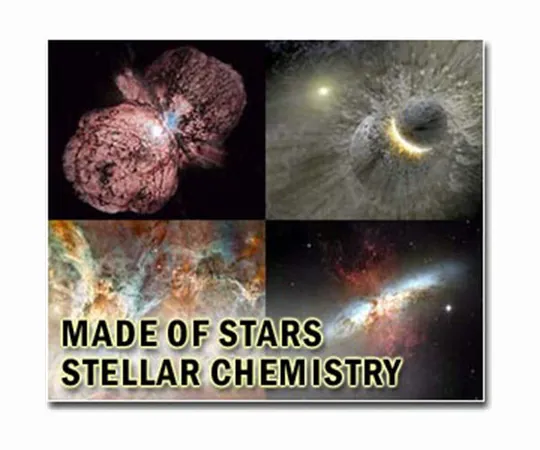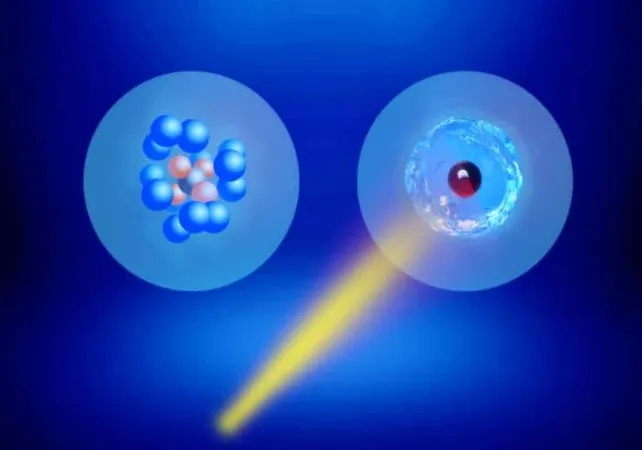
Galaxies Stopped Growing Much Earlier Than Expected: A Groundbreaking Discovery!
2025-04-03
Author: Mei
Groundbreaking Discovery
For decades, the prevailing wisdom in astronomy suggested that the earliest epochs of the Universe were dominated solely by star-forming galaxies. However, recent findings from the James Webb Space Telescope (JWST) have dramatically disrupted this long-held belief. A collaborative international team, led by researchers from the University of Geneva (UNIGE), has identified the most distant quiescent galaxy known to date, revealing that some galaxies ceased star formation much earlier than anticipated. This revelation represents a deepening divide between theoretical cosmic models and actual observations regarding galaxy evolution, as detailed in a study published in the Astrophysical Journal.
The Process of Galaxy Growth
In the early Universe, galaxies traditionally pulled in gas from intergalactic space to fuel continuous star formation, a self-sustaining phenomenon. This process, called galaxy growth, eventually reaches a halt due to a phenomenon known as 'quenching.' Currently, in the nearby Universe, nearly 50% of all observed galaxies are classified as 'quenched,' meaning they no longer produce new stars. Often termed 'red and dead,' these galaxies take on a reddish hue due to the absence of young, hot blue stars and are primarily composed of older, cooler stellar populations.
Understanding Quiescent Galaxies
Quiescent galaxies are typically more prevalent among larger galactic systems, particularly those with elliptical structures. Historically, the formation of these galaxies was believed to be gradual, involving extensive star formation before quenching occurs. Yet, the exact triggers of this quenching process remain fiercely debated among astronomers. "Identifying early massive quiescent galaxies (MQGs) is crucial for understanding their formation mechanisms," explained Pascal Oesch, an associate professor at UNIGE and a co-author of the study. Finding these early systems has been a longstanding goal in the field of astrophysics.
Advanced Observations with JWST
Utilizing advanced spectroscopic techniques, particularly in the near-infrared spectrum, astronomers have uncovered MQGs at increasingly earlier stages of cosmic history. These observations challenge existing models that posit such galaxies should take longer to form. Thanks to JWST, researchers have now extended the observational boundary to a redshift of 5, indicating events that took place just 1.2 billion years after the Big Bang. This new research implies that the processes of galaxy formation and quenching may have occurred significantly earlier than previously thought.
RUBIES Program Findings
Part of the JWST Cycle 2 initiative, the RUBIES program (Red Unknowns: Bright Infrared Extragalactic Survey) has leveraged the NIRSpec instrument to capture spectra from thousands of galaxies, unveiling several noteworthy discoveries based on early JWST images. Among these findings is the most distant MQG ever recorded—dubbed RUBIES-UDS-QG-z7—boasting a redshift of 7.29. This galaxy had already halted star formation a mere 700 million years following the Big Bang. Remarkably, spectral data suggest that it harbored an unexpectedly mature stellar population, having accumulated more than 10 billion solar masses of stars within just the first 600 million years before ceasing to form new stars.
Implications for Galactic Evolution
"The discovery of RUBIES-UDS-QG-z7 indicates that massive quiescent galaxies in the Universe's first billion years are over 100 times more abundant than any current model predicts," asserted Andrea Weibel, a PhD student at UNIGE and lead author of the study. Such findings indicate that existing galactic evolution models—potentially overlooking critical elements such as feedback from black holes or stellar winds—may require drastic revisions. The idea that galaxies could quench their star formation this early complicates our understanding of cosmic history.
Characteristics of RUBIES-UDS-QG-z7
RUBIES-UDS-QG-z7 displays notable compactness, stretching across merely 650 light-years. Its dense stellar configuration mirrors that of the quiescent galaxies we see at lower redshifts, specifically between 2 and 5. These characteristics suggest that such early systems might represent the dense cores of today’s massive elliptical galaxies.
Conclusion
"This discovery provides compelling evidence that the centers of some of the massive elliptical galaxies we observe today may have already formed in the first few hundred million years after the Big Bang," concluded Anna de Graaff, the principal investigator of the RUBIES program and a postdoctoral researcher at the Max Planck Institute for Astronomy. As we delve deeper into the cosmos with advanced technology like the JWST, each discovery reveals further complexities about the universe we inhabit, challenging our foundational theories and spurring new questions about the cosmic evolution we continue to unravel.





 Brasil (PT)
Brasil (PT)
 Canada (EN)
Canada (EN)
 Chile (ES)
Chile (ES)
 Česko (CS)
Česko (CS)
 대한민국 (KO)
대한민국 (KO)
 España (ES)
España (ES)
 France (FR)
France (FR)
 Hong Kong (EN)
Hong Kong (EN)
 Italia (IT)
Italia (IT)
 日本 (JA)
日本 (JA)
 Magyarország (HU)
Magyarország (HU)
 Norge (NO)
Norge (NO)
 Polska (PL)
Polska (PL)
 Schweiz (DE)
Schweiz (DE)
 Singapore (EN)
Singapore (EN)
 Sverige (SV)
Sverige (SV)
 Suomi (FI)
Suomi (FI)
 Türkiye (TR)
Türkiye (TR)
 الإمارات العربية المتحدة (AR)
الإمارات العربية المتحدة (AR)